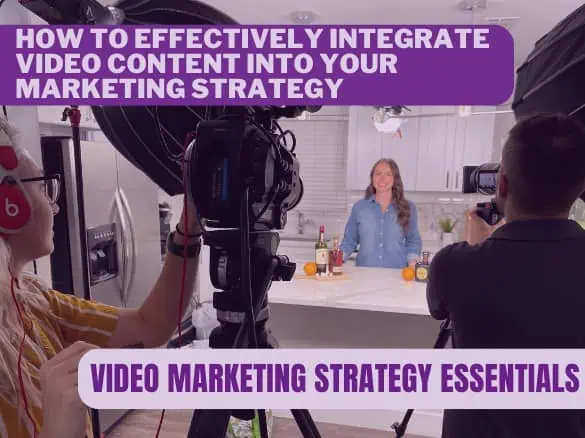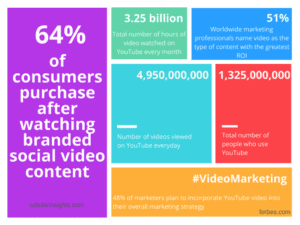Business Success = Business Video in 2025
A business video is no longer optional—it’s a cornerstone of any successful marketing strategy. We covered that in our last post about how video has become the new business card for business. As we move into 2025, video content continues to dominate, accounting for 82% of all internet traffic (Cisco). Customers now expect this as a primary way to interact with brands, whether to learn about a product, understand a service, or get a behind-the-scenes look. Here are seven reasons why video is a must for your business this year.
1. Marketing Strategy: Build Trust with a Human Touch with a Business Video
Trust is the foundation of any successful business relationship, and video is one of the most effective ways to establish it. Customers are looking for authenticity—they want to see the people behind the brand, not just a faceless logo or a cartoon. Video can be one of the best tools in your marketing strategy.
A heartfelt message from your CEO, a behind-the-scenes tour of your operations, or even a quick introduction to your team can make your business feel more relatable. According to research, 70% of consumers feel more confident about a purchase after watching a video (Wyzowl). When you put a face to your brand, you create a sense of connection that text or static images just do not achieve.
For example: A tutoring school might create a series of content introducing their tutors, showcasing their personalities and expertise. What parent wouldn’t want to see and hear what their child’s tutor is like before connecting them? This makes potential customers feel comfortable before even stepping through the door.
2. Communicate Quickly and Effectively via your Marketing Strategy
Attention spans are shrinking, and competition for your audience’s time is fierce. Video allows you to communicate complex ideas faster and more effectively than text or images alone. In fact, viewers retain 95% of a message compared to just 10% through text (InVideo).
A short, well-produced video can condense pages of information into an engaging, easy-to-understand visual story. Whether you’re marketing strategy explains a product feature, introduces a new service, or shares customer success stories, video helps your message land quickly and stick.
Tip: Use video to simplify technical concepts. For example, a software company might create explainers to walk users through their product’s functionality step-by-step.
3. Education = Influence
When you educate your customer, they begin to trust you. When you add value to their lives by teaching them something they didn’t know you are in a position of authority and integrity. Teaching them something new in an exciting way like video, you can help them make future decisions. When you position yourself in a position of educating and teaching, it’s obvious who they’ll remember when they need more information or when it comes time to make a purchase. It’s another powerful form of creating trust. Here’s an example:
4. Demonstrate Products with Clarity
Customers are increasingly reliant on video to understand how products or services work before they buy. According to Google, 55% of shoppers use online video while shopping in-store to learn more about a product (Google Shopping Trends).
Videos allow you to highlight features, demonstrate functionality, and answer common questions visually. This is particularly useful for products that require some assembly, comparison, or a bit of explanation…and likely reduces the amount of returns the retailer or manufacturer might incur.
For example: Think about the power of an unboxing video. An e-commerce brand selling tech gadgets can create professional unboxing videos to show customers exactly what they’re getting, how to set it up, and what makes it special.
5. Strong Sales Tool: Let Your Customers Do the Talking
Customer testimonials. are the best way to build credibility, and video takes them to the next level. Seeing and hearing real customers share their experiences with your product or service adds an emotional layer that text testimonials lack. The tone of voice, facial expressions, and body language make the story more relatable and memorable.
Testimonials work well in industries where trust is critical, such as healthcare, finance, or professional services. They can also provide social proof that others like your potential customers have succeeded by choosing you. In the nonprofit world, we’ve seen huge donations as a result of a very thankful recipient of a nonprofit’s service helped them in a difficult time.
Tip: Capture a happy customer in a 30-second clip describing the problem they faced, how your business helped, and the results they achieved because of your help. Keep it authentic—scripted testimonials can feel less trustworthy.
6. Boost Your Online Visibility: Video Marketing
Search engines love video, and so do social media platforms. Including it on your website can improve your search rankings significantly, making it easier for potential customers to find you. According to HubSpot, including a video on a landing page can increase conversion rates by 80% HubSpot.
In addition to improving SEO, videos are highly shareable. Social media platforms prioritize this type of content in their algorithms, giving your posts a better chance of being seen. If you are looking to expand your reach, this is a powerful tool for visibility.
Quick tip: Optimize by adding relevant keywords to titles, descriptions, and tags. For example, if it is about how to use video marketing to grow your business, include that phrase in the title and meta description.
7. Marketing Strategy: Drive Conversions and Sales
Videos don’t just grab attention—they drive action. Whether your goal is to get a visitor to sign up for a newsletter, schedule a consultation, or make a purchase, this type of content can guide them toward that decision. A well-crafted one can move viewers through the sales funnel, from awareness to decision-making, more effectively than any other medium.
It also seems that most customers prefer to learn about a product or service through video, and those who watch product videos tend to be much more likely to purchase. The reason? It helps them feel confident they’re making the right choice. They can make an intelligent decision.
Example: For an online retailer, adding product videos to your e-commerce site can reduce returns by helping customers understand what they’re buying upfront.
8. Personalize Experiences and Reach the Right Audience
In 2024, consumers expect personalized interactions with brands, and video is one of the most effective ways to deliver them. With advancements in data-driven marketing and AI, you can create content tailored to specific segments of your audience—whether it’s addressing their unique needs, interests, or pain points. You can do this by driving target audiences to different content that speak to each of their needs.
For instance, personalized video emails have been shown to increase click-through rates by up to 300% (VidYard). Similarly, targeting niche audiences with custom content on platforms like YouTube or LinkedIn allows you to speak directly to the decision-makers who matter most.
Live streams, interactive videos, and dynamic ads can engage users with content that feels relevant to them, fostering deeper connections and better results.
Pro Tip: For example, if you run a fitness brand, you might create separate content for beginners, advanced athletes, or those interested in yoga versus strength training.
Start Creating Video Content Today Video is no longer just an option for businesses—it’s a necessity. Whether you want to build trust, explain your services, or drive sales, video is the tool that delivers results. Ready to get started? We can help you create professional, impactful content tailored to your audience.
Related Articles:
How to Measure Video Marketing Success? 13 Useful Metrics
How Promotional Video Can Grow A Professional Services Business

















